Last Updated on December 17, 2018
As part of our Jane Austen 200th Anniversary Giveaway, readers were invited to pose questions to Caroline Jane Knight, direct descendant of Jane Austen’s brother, Edward Knight, and author of the new memoir Jane & Me: My Austen Heritage.
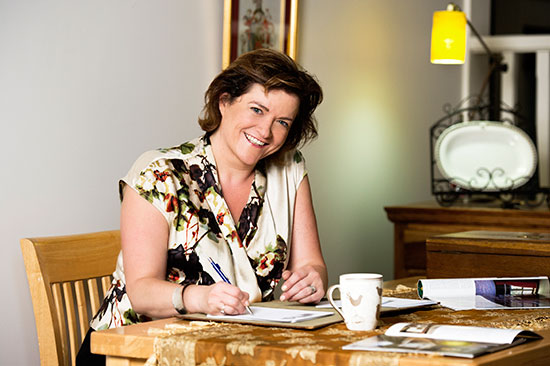
To help keep this site running: Willow and Thatch may receive a commission when you click on any of the links on our site and make a purchase after doing so.
Caroline read through everyone’s questions, and answers many of them about Jane Austen costume dramas, Chawton House, her Austen heritage, and others, below. The book is available for purchase here.

 Q: Have you watched many adaptations of Jane’s work? What are your thoughts about the different movies and television mini-series? Have you watched many adaptations of Jane’s work? What are your thoughts about the different movies and television mini-series?
Q: Have you watched many adaptations of Jane’s work? What are your thoughts about the different movies and television mini-series? Have you watched many adaptations of Jane’s work? What are your thoughts about the different movies and television mini-series?
CJK: The only production I saw at the time of release was BBC Television’s 1995 series of Pride & Prejudice, directed by Simon Langton, starring Colin Firth and Jennifer Ehle. It was so popular, I felt compelled to watch it and it was ground-breaking. Never before had Jane’s work been produced in such a natural, engaging way and it made a significant difference to the awareness and appreciation of Jane’s work. It stayed wonderfully faithful to the original text and was the first Austen production filmed entirely on location – rather than on tape in a studio – which made such a difference to the realism of the acting, and the setting. Colin and Jennifer developed a real life romance during the filming, which may also have contributed to the ‘heat’ between the characters on screen.
Personally I found it difficult to watch as it reminded me of what I missed so dearly: living in a country manor; long walks across the estate, avenues of trees and, of course, great-aunt Jane Austen and I chose not to watch any other film or television production.
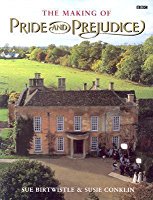 In 2014, I spent the day with Simon Langton in Chawton (it was he that first suggested I write my memoir), and he told me all about the process of making P&P 1995, and some of the mishaps! He subsequently wrote an article about it for Pride & Possibilities, the Jane Austen Literacy Foundation journal.
In 2014, I spent the day with Simon Langton in Chawton (it was he that first suggested I write my memoir), and he told me all about the process of making P&P 1995, and some of the mishaps! He subsequently wrote an article about it for Pride & Possibilities, the Jane Austen Literacy Foundation journal.
Since then, I have caught up and watched almost all of the televisions and movie adaptations of Jane’s work. I was interested to see the 1940s version of Pride & Prejudice starring Laurence Olivier and Greer Garson. Produced 55 years earlier, it is interesting to see how Jane’s work was adapted at this time (during the Second World War) – it is such a light-hearted take on the novel, riddled with costume anachronisms, but entertaining none the less. I also particularly enjoyed Bride & Prejudice, a Bollywood musical version of this classic tale told in modern India.
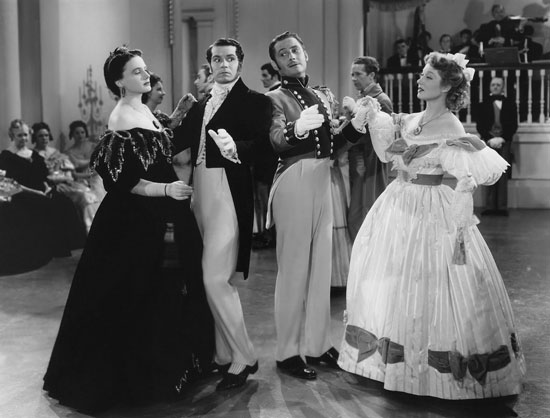
I particularly like the productions that capture the essence of Jane’s work, even if they do contain minor alterations to the story or dialogue. Emma Thompson’s Sense & Sensibility is a stand out – there were some changes to the original, for example the scene where Edward Ferrars helps coax Elinor and Marianne’s younger sister, Margaret, out from under the table in the study, and Emma Thompson’s role as Elinor caused some controversy (she was 16 years older than the character), but that didn’t detract from the wonderful tone, pace and spirit of the production.
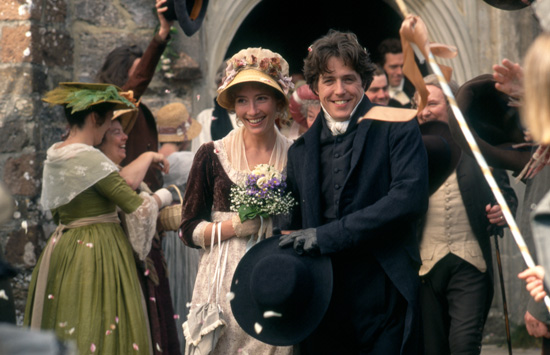
I am most troubled with the interpretations of Mansfield Park, a complex novel where the stark reality of the hierarchy of birth is plain to see (Fanny Price endures a level of cruelty from those she is required to show gratitude to) and the source of income and power of the rich is challenged. Despite it’s significant changes to the script, with the young Fanny Price taking on Jane’s own writing passion and early works as her own, Patricia Rozema’s 1999 movie version starring Francis O’Connor and Jonny Lee Miller is a compelling telling of Mansfield Park and the best version there is.
Gwyneth Paltrow’s is probably my favourite version of Emma, I particularly enjoyed Toni Collette’s portrayal of Harriett, although none of the adaptations of Jane’s fourth novel have truly captured Emma as I imagined her. Emma is a complex character – at the beginning of the novel she is a spoiled rich young woman with matchmaking schemes for her own amusement, who presumes to know what is best for others and fails to respect the wishes of those around her, or those less fortunate than herself. She learns some important life lessons on the way and eventually matures beyond her childish and selfish ways. It is challenging to portray a girl with such unlikeable characteristics, whilst endearing her sufficiently to the audience that they rejoice in her eventual union to Mr Knightley.
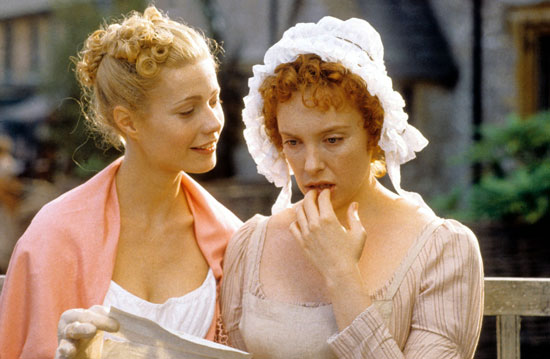
Persuasion 1995, starring Amanda Root as Anne Elliott and Ciaran Hinds as Captain Wentworth is easily my most favourite version of Jane’s last completed novel – it is so wonderfully romantic. It is the most natural adaptation of Jane’s work – unglamorised and authentic to the era Jane was writing in (the women wear no make-up) – and captures the essence of Jane’s masterpiece so wonderfully. There is much speculation that Anne Elliot is a near ‘self-portrait’, written during Jane’s final illness – if that is to be believed, then Amanda Root’s Jane Austen was far more believable to me than the portrayals of Jane in subsequent movies about her life.
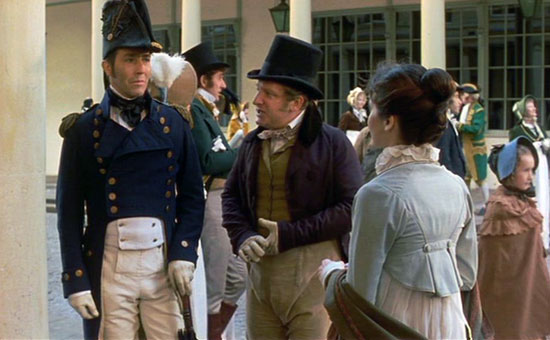
Northanger Abbey, a satire of gothic novels popular at the time, is my favourite of Jane’s published works. It is naughty and a bit cheeky, and shows a different side of Jane Austen. Despite being published after her death, it was written in her early 20s and is much less reserved than her later works. The 2007 adaptation starring Felicity Jones and JJ Field captures the fun and spirit of this work and is very watchable.
Most recently we have seen an adaptation of Lady Susan, rather confusingly released as Love & Friendship (the title of another of Jane’s early unpublished works) which I loved. It is a wonderful tale which again shows Austen’s humour and sharp wit.
 Q: How do you feel about the period films that imagine Jane herself?
Q: How do you feel about the period films that imagine Jane herself?
CJK: Having grown up with Jane Austen as such as strong and ever-present influence, I have my own picture of her and none of portrayals have come close. Productions such as Becoming Jane and Miss Austen Regrets are very watchable, but, for me, have made such extraordinary leaps of assumption, they cannot be considered to be a realistic portrayal of her life or personality.
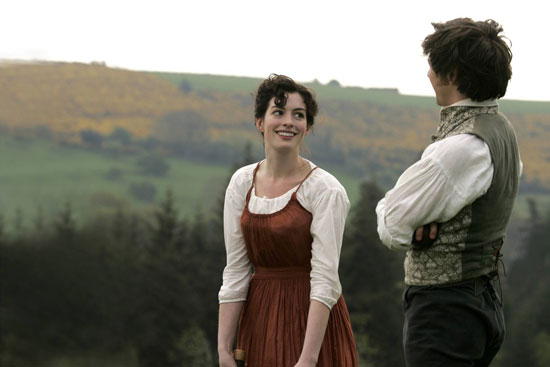
Having said that, I am mindful that I always find dramatizations of my family members uncomfortable to watch, and may never get used to it!
 Q: What would you like to see next from Austen adaptations?
Q: What would you like to see next from Austen adaptations?
CJK: Rather than an adaptation of her work, I would be particularly interested to see a telling of Jane Austen as a businesswoman. Despite many challenges and knock backs, Jane Austen has become one of the most successful writers the world has ever seen, and that is no accident. The Jane I grew up with was tenacious and determined. She no doubt wrote for pleasure, but she wanted her books to be commercially viable and took her ‘business’ very seriously. I don’t think the true story of ‘Jane the writer’ has yet been told.
 Q: How do you celebrate your Austen heritage?
Q: How do you celebrate your Austen heritage?
CJK: When we lived at Chawton, we didn’t celebrate our heritage, as such, we lived it. As best we could, we continued our long held traditions – a game of snapdragon in the Great Hall on Christmas eve (mentioned by Fanny Knight in her diary in 1806), putting holly in the hand of Sir Richard’s reclining statue in the church at Christmas every year (he had been there since 1680, so Jane would have known him as well as I did), and honouring our duty as hosts of many community events, including the annual general meetings of the Jane Austen Society of the UK. With the family fortune long since gone, Granny (Elizabeth Knight) ran a tea room from the Great Hall at the front of the house and we welcomed thousands of Janeites into our home every year – Jane was frequently discussed. Thirty years on and I celebrate my Austen heritage by sharing my experience of growing up in Jane’s world (with my book Jane & Me: My Austen Heritage and live talks – I am currently touring Australia, and will be visiting the US later in 2017).
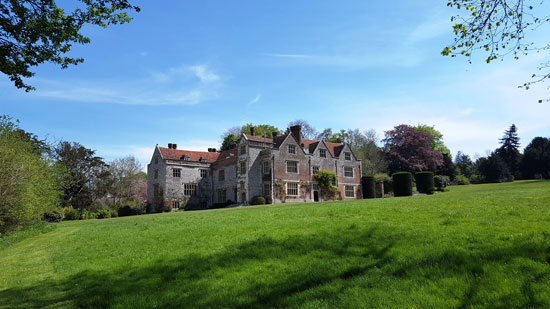
As founder and chair of the Jane Austen Literacy Foundation, I work with the Jane Austen community every day to improve literacy rates, in honour of Jane. For me, that’s the best way I can celebrate and honour my Austen heritage.
 Q: I have been wanting to write a novel about my family history but I have no clue when and how to even start. Do you have any advice for college students contemplating writing a book on the topic?
Q: I have been wanting to write a novel about my family history but I have no clue when and how to even start. Do you have any advice for college students contemplating writing a book on the topic?
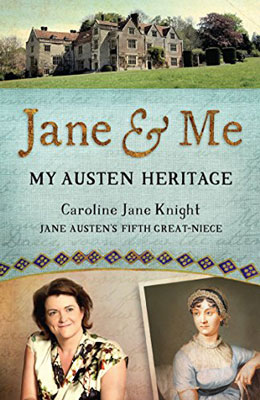 CJK: I am a first time author – I had never even considered writing a book until I decided to write Jane & Me: My Austen Heritage – so had no idea what I was doing when I started. I had a childhood of memories to make sense of, so many stories I had heard covering a four hundred year history of Knights, Austens and great-aunt Jane. Some of the stories I knew very well, others I needed to research or revisit with my family to be sure of the details. Before I started writing, I tried to write an outline of what every chapter would be, but I couldn’t – I didn’t know how I was going to tell the story. So, I decided to just start writing. I wrote passages about different topics, some of which required a lot of drafts, thought and research, others that just came out of me in one sitting and have never been changed. In the beginning, I gave myself the absolute freedom to write what I wanted to write about that day, in the way I wanted to write it – I didn’t worry about the ‘rules’ until later on. For example, chapter 7 is about the death of my grandfather, Edward Knight III, the fifteenth squire of Chawton and Edward Austen’s great great grandson, after which we had to leave to make way for his heir (my father’s older brother). For months I had struggled to even think about writing this chapter but one morning I woke up with the urge to write it, sat down, and completed the chapter in a few short hours – it just flowed out of me.
CJK: I am a first time author – I had never even considered writing a book until I decided to write Jane & Me: My Austen Heritage – so had no idea what I was doing when I started. I had a childhood of memories to make sense of, so many stories I had heard covering a four hundred year history of Knights, Austens and great-aunt Jane. Some of the stories I knew very well, others I needed to research or revisit with my family to be sure of the details. Before I started writing, I tried to write an outline of what every chapter would be, but I couldn’t – I didn’t know how I was going to tell the story. So, I decided to just start writing. I wrote passages about different topics, some of which required a lot of drafts, thought and research, others that just came out of me in one sitting and have never been changed. In the beginning, I gave myself the absolute freedom to write what I wanted to write about that day, in the way I wanted to write it – I didn’t worry about the ‘rules’ until later on. For example, chapter 7 is about the death of my grandfather, Edward Knight III, the fifteenth squire of Chawton and Edward Austen’s great great grandson, after which we had to leave to make way for his heir (my father’s older brother). For months I had struggled to even think about writing this chapter but one morning I woke up with the urge to write it, sat down, and completed the chapter in a few short hours – it just flowed out of me.
As I wrote more and more over about eighteen months, the structure and vision of the book became clear. For the last six months of writing, I took a very disciplined approach to structure and finish the book – I could have easily carried on for another year at least, but you also have to know when to stop.
 Q: Did you discover anything new about your family when you were doing preparation for your book?
Q: Did you discover anything new about your family when you were doing preparation for your book?
CJK: Yes, I found out a lot about my family. Strangely enough, I think I knew more about my ancestors than my living family. I spent hours with my grandmother, baking and preparing for events, but we never talked about ourselves – I don’t know how she felt about anything, we just didn’t talk in that way. My grandfather, Edward Knight III, was a very private man and, although we lived in the same house and saw each other every day, the only conversation I ever had with him was on his deathbed when I was seventeen. As a child I never understood what had happened to the family fortune. At the turn of the 20th century, Montagu Knight owned all but two houses in Chawton, but by the time my father was a boy, all that remained was Chawton House (which had tenants living in the servants wing), and a few run down out buildings. My grandfather inherited in 1932 and I always wondered what he had done with all of the money but such things were never discussed.
I also found out some extraordinary information about our lineage and about Elizabeth Martin Knight, who inherited in 1702 – Jane definitely knew about her. But, I don’t want to give away too much: it’s quite a twist at the end of my book!
 Q: Why do you think Jane never married?
Q: Why do you think Jane never married?
CJK: I am often asked what I would most like to ask Jane and this is it – why did she refuse Harris Bigg-Wither’s proposal? There is no doubt that she didn’t love him, or respect him particularly, but it was still an extraordinary decision for a woman of her situation. Jane obviously thought it was the right decision for her (and who am I to argue), and it turned out well in the end for all of the Janeites of the world (it is unlikely she ever would have published her novels had she married), but I would love to know what conversation she had with Cassandra after she had accepted the proposal, that resulted in her changing her mind the next morning. This was the only proposal Jane ever received – she never received an offer from someone she admired, so we don’t know if she would have refused any offer of marriage, or just one from a man who was ‘very plain in person – awkward, and even uncouth in manner’ as Caroline Austen described Mr Bigg-Wither.
 Q: What were some of the centuries-old Christmas traditions celebrated in the Great Hall of Chawton House?
Q: What were some of the centuries-old Christmas traditions celebrated in the Great Hall of Chawton House?
CJK: For fifteen generations the Great Hall was used to host official visitors, community events and the private celebrations of our family, and it was used for the same purpose when I was a child. We didn’t use if for everyday meals, but loved setting Edward Austen’s grand dining table for a family lunch when our extended family came to visit, or to celebrate a special birthday or anniversary. Our most traditional night of the year was Christmas Eve, when we enjoyed a game of Snap-Dragon. Fanny Knight writes about Snap-Dragon in a letter in 1806, a traditional Christmas Eve game in Jane’s time, so we know the family have enjoyed it since at least that time. Snap-Dragon is a game where you have to put your hands into flames to retrieve brandy soaked fruit – it doesn’t sound like fun, but it was spectacular and it was our favourite night of the year. It comes complete with the Snap-Dragon chant, which begins:
Here he comes with flaming bowl,
Don’t he mean to take his toll,
Snip! Snap! Dragon!
It was easy to imagine the room filled with the same laughter and excitement from generations of my family over the centuries, and great-aunt Jane leading the chant. I loved it so much, that the first chapter of Jane & Me: My Austen Heritage is about Christmas Eve 1986, the last time we played Snap-Dragon as a family before my grandfather, Edward Knight III (Edward Austen’s great great grandson) died and the wheels fell off. I give the reader a front row seat at our most traditional night of the year.
 Q: I guess I don’t know enough about Jane’s family history: why is she Jane Austen and her brother Knight? Did she use a different/partial name or did Edward’s name change?
Q: I guess I don’t know enough about Jane’s family history: why is she Jane Austen and her brother Knight? Did she use a different/partial name or did Edward’s name change?
CJK: Jane grew up in Steventon, a small village in Hampshire, in the south of England. Her father was the rector of Steventon, which was owned by his distant cousin Thomas Knight. Thomas was the owner of three large country estates—Chawton, Steventon and Godmersham—further land and property in Sussex and Essex, and May’s Buildings which he had built in St Martin’s Lane in London. Thomas left his properties and fortune to his son, Thomas Knight II, in the traditions of estate succession. Thomas Knight II, and his wife Catherine, didn’t have any children of their own and, in need of an heir, adopted Jane’s brother Edward Austen, who was about 15 at the time. As a condition of Edward’s inheritance, he changed his (and therefore my) name from Austen to Knight. We all know him as Edward Austen Knight, although he never carried that name.
 Q: Do you have a favorite family heirloom?
Q: Do you have a favorite family heirloom?
CJK: The only conversation I ever had with my grandfather, Edward Knight III, or Bapops as we called him, was on his deathbed, despite spending seventeen years living together at Chawton House. He was a very private man, only accessible to a very small group of close family trusted advisors. We had no relationship but I loved and respected him as the head of our family and the ‘king’ of everything I could see. After he died, Granny gave me a personal possession of his that he wanted me to have – an extraordinary act of love from beyond the grave – and it is my most precious heirloom. His death changed the lives of so many people and, for now (my uncle still owns the freehold of Chawton, so who knows what the future might bring) closed 400 years of history. It was such a significant moment for our family, the end of the Austen’s in Chawton, I have dedicated a whole chapter to this difficult time – and the precious item that Bapops left me.
I also love the Knight Family Pedigree Book, which details the family trees of every branch of the Knight family that owned Chawton, including my branch, the Austens. It was started in the 17th century, with the last entries being made in the early 20th century, and included beautifully hand-painted coats of arms, and written entries for every member of the family, including Jane Austen. For now, this has been kept private, but I’m sure will be shown in public at some point.
 Q: Do you, perchance, own anything once belonging to Jane? Or Cassandra? Or?
Q: Do you, perchance, own anything once belonging to Jane? Or Cassandra? Or?
CJK: Not personally. As well as in Chawton, Jane’s possessions were kept by different branches of the family over the years, and have ended up all over the world. One of the marvellous things that has happened, particularly over the last 20 years with Jane’s phenomenal rise to global ‘fame’, is the return of many of Jane’s possessions to Jane Austen’s House Museum in Chawton. When I was a child, we would run around Jane’s house (400 metres from the Great House, where I grew up), sit behind her desk and touch whatever we wanted. Last time I visited, I was struck with the security now in place and the expanded collection of Jane’s things.
 Q: Does your family still have any possessions owned at one time by Jane or her immediate family?
Q: Does your family still have any possessions owned at one time by Jane or her immediate family?
CJK: The most notable possession would be the Austen Knight dinner service made by Wedgwood following a visit Jane and Edward made to their London showroom in 1813. The design is inspired by our coat of arms and was never offered to the public for sale. The only set was made privately for my family, Jane would have known it very well and eaten from it often and we are lucky that the dinner service has survived. It now belongs to my father, and very occasionally is used by my parents for the most special of family occasions.
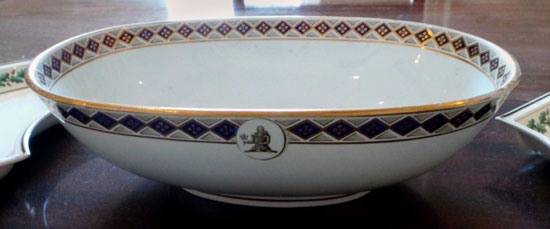
As well as the dinner service, Jane and I shared the same rooms, walks, family traditions, furniture and the same family library – 3000 books put together over generations of the family, many complete with a bookplate to show which member of the family had originally owned the book. Jane had ready access to this library and would have looked at many of the same books as me. This access to the inner workings of her rich brother’s estate and the family library are said to have been of great assistance to Jane in her writing. I spent hours as a child looking for a copy of Jane’s novels in the Knight family collection, as it is known, but they weren’t there. Jane Austen’s novels were not in the library of her own family! It was years later I found out why and I reveal all in my book.
 Q: Does your extended family have Austen-Knight reunions?
Q: Does your extended family have Austen-Knight reunions?
CJK: There have been two family reunions since we left Chawton in 1988. It has only been since 2014 that I have wanted to embrace my heritage – for 25 years it was something I rejected and wanted nothing to do with – so unfortunately I declined both invitations and did not attend either. It was my father’s 70th birthday in 2014, and the celebrations were held at Chawton House, so I did get to spend the afternoon with old friends and our extended family back in Chawton, which was wonderful.
 Q: I have read in Jane’s letters that she was in charge of the tea purchases and drank Twinings. Do you have a favorite brand and flavor?
Q: I have read in Jane’s letters that she was in charge of the tea purchases and drank Twinings. Do you have a favorite brand and flavor?
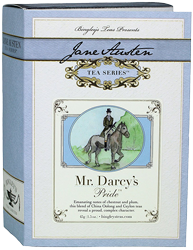 CJK: I have to confess, I am not much of a tea drinker, none of my family are. We served a lot of tea to Jane Austen devotees who came to visit Granny’s tea room in the Great Hall, where I earned my pocket money as a teenager, and at the many annual events we hosted – PG Tips was the brand Granny bought – but privately we drank more coffee than tea.
CJK: I have to confess, I am not much of a tea drinker, none of my family are. We served a lot of tea to Jane Austen devotees who came to visit Granny’s tea room in the Great Hall, where I earned my pocket money as a teenager, and at the many annual events we hosted – PG Tips was the brand Granny bought – but privately we drank more coffee than tea.
I do think the Jane Austen inspired range of teas from Bingley Teas look wonderful and we use these blends when we do ‘High Tea for Literacy’ events to raise money for the Jane Austen Literacy Foundation, which I set up a few years ago.
 Q: I always wondered how it was like for you to meet people who absolutely love Jane Austen. Do you feel it as a weight on you or an honour?
Q: I always wondered how it was like for you to meet people who absolutely love Jane Austen. Do you feel it as a weight on you or an honour?
CJK: It can be both. From time to time people are overcome with emotion or react almost as if they were meeting Jane herself, and I worry that people will be disappointed if I don’t live up to their expectations, or can’t explain Jane’s inner thoughts and feelings about every subject, as I am often expected to do.
But mostly it is a huge honour. I cannot think of a single woman I would prefer to have grown up with or to have had as a role model. Even as a young girl I felt empowered and have never considered my gender as any restriction. Jane Austen was not perfect, none of us are, but she has become a beacon of hope for women (mainly) who are inspired by her writing, her characters and what she achieved in such difficult circumstances. It is an absolute honour to meet Jane Austen lovers – it is extraordinary to see the profound effect that Jane – our Jane – has had on so many lives, and it is such a thrill to be able to share my memories and, in a small way, bring people a little closer to Jane.
 Q: Does Chawton House have secret passages?
Q: Does Chawton House have secret passages?
CJK: There was always said to be a passage from the house underground to the church, but I don’t think any evidence of this was found during the restoration.
Although not secret to those of us who know the house intimately, it is very easy to get lost in Chawton House – it has been added to and altered over the centuries in keeping with the tastes and requirements of each Squire. The result was a labyrinth of staircases, passages and rooms. The dark interior and numerous interconnecting doors only add to the confusion. The layout is complicated, and it is difficult to describe—visitors frequently got lost.
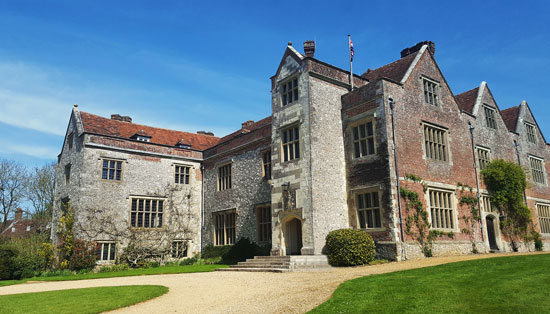
Fanny Knight, Edward’s eldest daughter and one of Jane’s favourite nieces, wrote to her old governess Miss Chapman in 1807 describing the Great House: “This is a fine large old house, built long before Queen Elizabeth I believe, & here are such a number of old irregular passages &c &c that it is very entertaining to explore them, & often when I think myself miles away from one part of the house I find a passage or entrance close to it, & I don’t know when I shall be quite mistress of all the intricate, & different ways.”
The house does have a number of secret places to hide, a secret cupboard just big enough for one person to hide in one of the staircases and in the chimneys, and a half room hidden in the walls that was discovered in the restoration in the 1990s.
 Q: I know this is a simple question, but I always like to ask people which Jane Austen novel is their favorite, so I offer this question to you.
Q: I know this is a simple question, but I always like to ask people which Jane Austen novel is their favorite, so I offer this question to you.
CJK: One of the things I love most about Jane’s work is the variety we get from just six completed novels – it’s hard to pick a favourite! But one of Jane’s stories is particularly close to my heart is Emma as it was talked about most in my family. Unlike her previous works that focus on women who face displacement, or have been displaced, from their home, Emma is about ‘noblesse oblige’ – the responsibilities that come with privilege. My grandparents’ position in the community, with the vast majority of property and land sold decades prior, was not what it once had been, but the values lived on. Granny did not tolerate gossip of any kind and treated everyone who visited with equal respect, from Sir John Junor (British media giant in 1970s and 80s) to the tramp that used to come and ask for food in the winter.
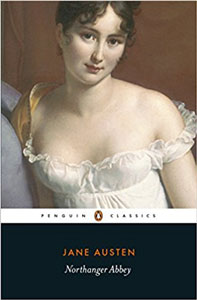 Even in our darkest hours, after my grandfather died when we faced having to leave our home of four centuries, fifteen generations and great-aunt Jane Austen, Granny insisted the duties and responsibilities of the ‘Knightley’s’ were fulfilled until our very last day. You see, I was always told that Mr Knightley was so named as a tribute to the Knight family and Edward Austen Knight – without whom Jane Austen may never been able to finish her stories, let alone publish any. By 1809 Mrs Austen and her daughters Jane and Cassandra were lodging in Frank Austen’s house in Southampton, no longer able to afford their own home after the death of Jane’s father, George Austen. Jane’s writing had all but stopped until Edward gifted his mother and sisters a large cottage in the middle of Chawton. Once settled in Chawton, Jane set about revising earlier drafts of Sense & Sensibility and Pride & Prejudice for publication, before she wrote new stories starting with Mansfield Park and Emma.
Even in our darkest hours, after my grandfather died when we faced having to leave our home of four centuries, fifteen generations and great-aunt Jane Austen, Granny insisted the duties and responsibilities of the ‘Knightley’s’ were fulfilled until our very last day. You see, I was always told that Mr Knightley was so named as a tribute to the Knight family and Edward Austen Knight – without whom Jane Austen may never been able to finish her stories, let alone publish any. By 1809 Mrs Austen and her daughters Jane and Cassandra were lodging in Frank Austen’s house in Southampton, no longer able to afford their own home after the death of Jane’s father, George Austen. Jane’s writing had all but stopped until Edward gifted his mother and sisters a large cottage in the middle of Chawton. Once settled in Chawton, Jane set about revising earlier drafts of Sense & Sensibility and Pride & Prejudice for publication, before she wrote new stories starting with Mansfield Park and Emma.
As I mentioned above, I also have a soft spot for Northanger Abbey, because it is so different from the others, and dispels any myths that have existed about Jane as a dull and boring woman!
 Q: Do you have a character from any of Jane Austen’s works that you related to especially?
Q: Do you have a character from any of Jane Austen’s works that you related to especially?
CJK: I don’t think I will ever be able to read Jane’s work through the eyes of a normal reader and I have written a whole chapter on my first discovery of her stories as a teenager – they were spookily reflective of our family situation and I found it quite disturbing.
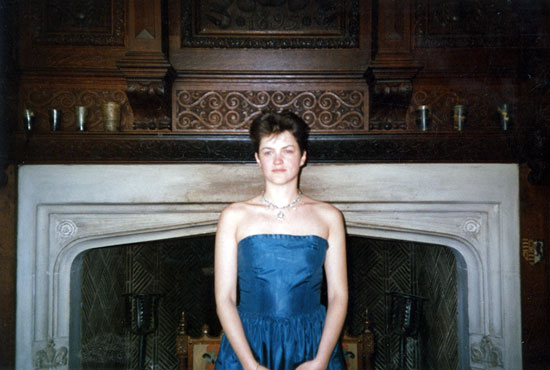
Oh how I wish I could say Elizabeth Bennet, or one of Jane’s other heroines, but the character I very first connected with, that has always stayed in my mind is Mrs Bennet! Although I had read bits and pieces as a younger child, I first read Pride & Prejudice cover to cover when I was 16. By then, I was beginning to accept that when my grandfather died, we would all have to leave Chawton House, which had belonged to my family for four hundred years. My grandfather’s heir, my father’s older brother Richard, didn’t live in Chawton but used to visit every year. I was troubled by the traditions of succession, entails and the like, but knew no one else who lived in a manor house, or had a grandfather who was a squire – we didn’t have the money to socialise with other people who lived in such grand surroundings. I didn’t know any other family with a named heir, from birth, who would inherit everything. And I was very worried about ‘what would become of us’ when the patriarch of our family died.
Like so many other things, it wasn’t talked about. Granny encouraged me to be accomplished (I can paint, cook, sew, decoupage etc), rather than the importance of my education, or how I might make my way in the world. But there, in the pages of Jane’s book, I found a similar tale, with a character who articulated my concerns. Jane no doubt pokes fun at Mrs Bennet, but she is not there purely as a character of amusement. Mrs Bennet gave us a sense of reality of the day, a time that is often described as ‘simpler’ than today – but I don’t think it was.
 Q: To what do you attribute Miss Austen’s continued popularity?
Q: To what do you attribute Miss Austen’s continued popularity?
CJK: Jane is popular all over the world, in different countries and cultures, with all age groups and a broad range for professions and interests. Jane’s phenomenal success is, I believe, down to a number of factors. Firstly, the sheer brilliance of Jane Austen’s writing, her wit and her characters, the everyday topics of human dynamics and societal mores that she writes about – still so relatable today, and the deep connection readers feel with her characters and Jane herself. Jane has become the ‘poster girl’ of an era of big country houses and old English traditions and that so many find intoxicating (the success of Downton Abbey, by way of another example). And it would be foolish to dismiss the power of Colin Firth and Hollywood! What I find fascinating is how different cultures find different connections with Jane’s novels – there are women all over the world that live in cultures that still severely restrict the freedom and choice of women. To us in the western world, the social challenges faced by Lizzie Bennet are historical, but to others they are all too real.
 Q: When did you first realize you were related to Jane Austen?
Q: When did you first realize you were related to Jane Austen?
CJK: I spent the first 18 years of my life living at Chawton Great House, which belonged to Jane Austen’s brother, Edward Austen Knight, my fourth great grandfather. Edward had been adopted by rich, but childless, fourth cousin Thomas Knight II, to inherit a number of country estates including Chawton, on the condition he changed his (and therefor my) name to Knight. Great-aunt Jane Austen’s house, where she lived, wrote and published her most famous works is four hundred metres from the Great House, as Jane called it. Jane is part of my family, her house is close by and Janeites visited our home throughout the summer for tea. I have always known about Jane, she was part of our everyday lives. From as young as I can remember, I knew Jane was witty and intelligent, a brave pioneer, a woman who had a dream and was determined to succeed. She was a wonderful and very powerful role model to grow up with.
 Q: What was it like growing up at Chawton House?
Q: What was it like growing up at Chawton House?
CJK: Chawton House is a large tudor manor house, built during the reign of Queen Elizabeth 1st, characterised by dark oak panelled rooms, stone lead light windows and lots of rooms – at least fifty. I had the rare privilege of growing up surrounded by 400 years of my own heritage and the legacy of my famous great-aunt, Jane Austen. We shared the same walks, rooms, family traditions, library, furniture as Jane – we even ate of the same china.
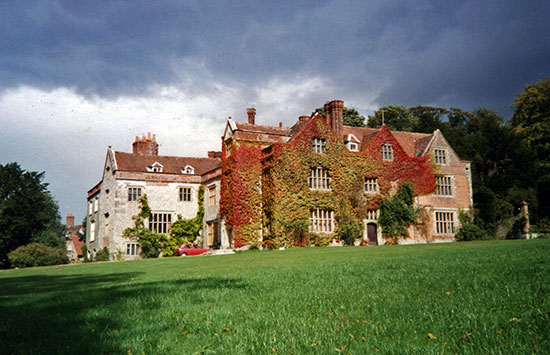
Portraits, statues, stained glass windows, carvings, bookplates, plaques, gravestones, furniture and crockery carried the family name or coat of arms and etched our Austen and Knight heritage into the fabric of the estate and my heart. I was born in 1970, by which time every other property and landholding had been sold, along with most of our valuable heirlooms. But it was a magical place to grow up and I am grateful to have known Chawton House as a family home.
 Q: Can you describe Chawton Great House for us?
Q: Can you describe Chawton Great House for us?
CJK: The Knight family were first recorded in Chawton in 1307. Their status and wealth grew over the centuries until they were able to buy the manor of Chawton including the site of Chawton House, built by John Knight around 1585. It is a large tudor manor house, built during the reign of Queen Elizabeth 1st, characterised by dark oak panelled rooms, stone lead light windows and lots of rooms – I can count a least fifty in my head, excluding the cellars and out buildings. Many of the other country houses in the area were destroyed by Oliver Cromwell’s army, but at the time he was coming through the south of England, Chawton had recently been inherited by the 5th Squire, Sir Richard Knight who was only 2 years old and too young to be expected to pledge allegiance to either the King, or Cromwell, so Chawton was ignored.
We are very lucky to have our tudor house – many other grand houses in the south of England we rebuilt in the 18th century. Chawton House has never been sold, it has been passed down from one generation to the next and subject to continual additions and alterations in line with the taste and requirements of each squire. The result is a labyrinth of staircases, passages and rooms. The dark interior and numerous interconnecting doors only add to the confusion. The layout is complicated, and it is difficult to describe—visitors frequently got lost. But it was a wonderful home – the house and grounds provided hours of entertainment and imagination.
The house sits at the end of the village halfway up a hill, with the garden and grounds reaching up further still behind the house. A straight gravel drive led down from the road to Chawton Church, St Nicholas, on the right and the stables on the left, before going up the hill to the front entrance. The natural dip in the landscape around the house had once provided a moat and later a ha-ha—or dry moat—a recessed fence that provided boundaries but did not obscure the view.
At the front of Chawton House was Granny’s tea room in the Great Hall. Jane Austen devotees who came to Chawton to visit Jane Austen’s House Museum, retraced Jane’s steps and took the short walk to her brother’s house for tea. From as young as I can remember, I was talking to visitors about great-aunt Jane, and during my teens I earned my pocket money serving customers in the tea room, where Jane was a regular topic of conversation.
 Q: Which was your favorite room at Chawton House?
Q: Which was your favorite room at Chawton House?
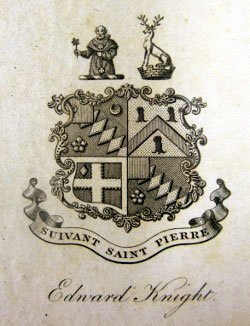 CJK: The library was the heart of our home. Not only did my grandparents use it as their sitting room, it also housed the Knight family collection – three hundred books compiled by fifteen generations of my family. Jane enjoyed access to the family libraries in Chawton and Godmersham Park (another of Edward Austen’s country estates, in Kent, sold in 1874) and she would have known many of the books I looked at as a child.
CJK: The library was the heart of our home. Not only did my grandparents use it as their sitting room, it also housed the Knight family collection – three hundred books compiled by fifteen generations of my family. Jane enjoyed access to the family libraries in Chawton and Godmersham Park (another of Edward Austen’s country estates, in Kent, sold in 1874) and she would have known many of the books I looked at as a child.
Most of the books carry bookplates to signify which of my ancestors originally owned the book. I was fascinated by the choice of bookplate design as it seemed to be an indication of the personality of each Squire, as was their choice of books. On the shelves sitting side by side were the personalities and choices of generations. I knew the faces of each Squire from their portraits; the bookplates brought them to life.
Although I have never written before my recent memoir, Jane & Me: My Austen Heritage, I have always had a connection to books. They were a link to our ancestors and the human side of life. And it was Jane’s books that brought visitors to our home throughout the summer for tea. There were also some old photograph albums in the Knight family collection – I loved looking at old photographs of the house, and particularly the finery worn by the ladies like the ones pictured here.
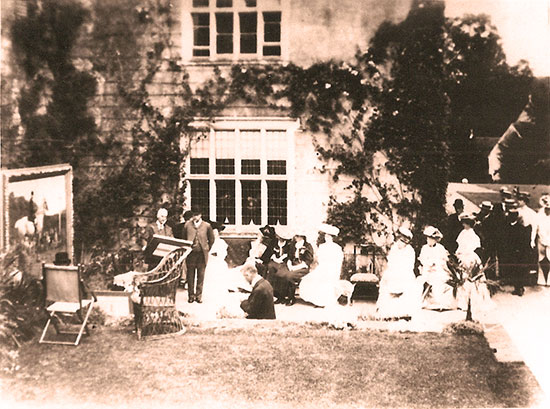
 Q: Why did your family leave the Great House in Chawton?
Q: Why did your family leave the Great House in Chawton?
CJK: Death duties were introduced in 1894 and changes to estate economy in England were already well advanced by 1900. Land values had plummeted from 1870 as foreign imports undercut home produced products. Duties and taxes were crippling for the landowners of England. For many, labour forces had been depleted during the First World War and after the war many former estate worked sought alternative opportunities upon their return. The traditional structure of landed estates all over England collapsed. When my Grandfather died in 1987, he left a diminished estate in need of significant restoration and it simply wasn’t possible for it to be kept as a family home.
Chawton House has not been residential since we left – it is now a public building. It is on a long lease, with 99 years remaining, to a charity. The house was beautifully restored in the 1990s, saving it for future generations to enjoy. In 2003 it opened as Chawton House Library, an internationally respected research and learning centre for the study of early women’s writing from 1600 – 1830. Access to the library’s unique collection is for the benefit of scholars and the general public alike. The library houses a collection of early women’s writing from the period and the Knight family collection of books that I grew up with. Thirty years on and I celebrate my Austen heritage by sharing my experience of growing up in Jane’s world (with my book Jane & Me: My Austen Heritage and live talks… look for an announcement if 2017 US tour dates). As founder and chair of the Jane Austen Literacy Foundation, I work with the Jane Austen community every day to improve literacy rates, in honour of Jane. For me, that’s the best way I can celebrate and honour my Austen heritage.
 Q: What have you done since you left Chawton?
Q: What have you done since you left Chawton?
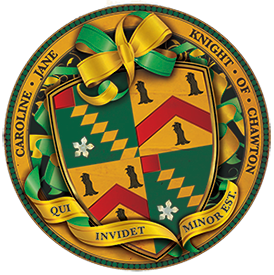 CJK: Leaving Chawton, my ancestors and Jane broke my heart – there’s no other way to say it – and I chose not to publicise my connections for over 20 years. I wanted to make it on my own and succeed on my own merits. After a tumultuous time in my twenties, I started a career in business in my early thirties and relocated to Australia in 2008 to become the CEO of a large field marketing company for the Photon Group, who at the time owned about forty-five agencies worldwide. In 2010 I joined the board of the charity Life Education, which empowers children and young people to make safer and healthier choices through education and not fall into drug addiction or alcohol abuse. In 2012 I joined the board of the Australian Institute of Management, training partner to over half the companies on the Australian Stock Exchange. That same year I was a finalist in the Telstra Businesswoman of the Year Awards. I left the corporate world in 2013 and started my own consultancy business and the Jane Austen Literacy Foundation. I live in a leafy village on the outskirts of Melbourne with my husband, two dogs and a few chickens.
CJK: Leaving Chawton, my ancestors and Jane broke my heart – there’s no other way to say it – and I chose not to publicise my connections for over 20 years. I wanted to make it on my own and succeed on my own merits. After a tumultuous time in my twenties, I started a career in business in my early thirties and relocated to Australia in 2008 to become the CEO of a large field marketing company for the Photon Group, who at the time owned about forty-five agencies worldwide. In 2010 I joined the board of the charity Life Education, which empowers children and young people to make safer and healthier choices through education and not fall into drug addiction or alcohol abuse. In 2012 I joined the board of the Australian Institute of Management, training partner to over half the companies on the Australian Stock Exchange. That same year I was a finalist in the Telstra Businesswoman of the Year Awards. I left the corporate world in 2013 and started my own consultancy business and the Jane Austen Literacy Foundation. I live in a leafy village on the outskirts of Melbourne with my husband, two dogs and a few chickens.
 Q: Can you tell us more about the Jane Austen Literacy Foundation?
Q: Can you tell us more about the Jane Austen Literacy Foundation?
CJK: I created the Jane Austen Literacy Foundation to harness the global passion for great-aunt Jane to fund literacy resources for communities in need across the world. We believe that everyone, no matter gender or circumstance, has the right to learn basic literacy skills. Many of us are very lucky and have the opportunity to receive an education where we can learn these invaluable skills. However, there are communities around the world where this is not so. Literacy rates in developing, low income and war torn countries are staggering, and the gap between men and women even more so.
Literacy is the building block of progress, for an individual, a community and the world. Without literacy, talent will be lost – can you imagine if Jane Austen hadn’t been taught to read or write?
We work alongside reputable charitable organisations such as UNICEF and The Australian Literacy & Numeracy Foundation and assist in funding basic materials like colouring pencils, pens, paper, children’s books and novels for communities in need.
The Jane Austen Literacy Foundation is a registered not for profit organisation run by volunteers. No wages or commission are paid so 100% of donations received are used to buy literacy resources. Janeites all over the world can help by making a donation, raising money with a raffle or an event, by choosing which projects they want their donations to fund, and by volunteering to help with the operations of the foundation – from administration to project management.
 Q: Why did you write Jane & Me: My Austen Heritage?
Q: Why did you write Jane & Me: My Austen Heritage?
CJK: In 2013, with the bi-centenary celebrations of the publishing of Pride & Prejudice, I realised just how popular Jane had become, and the amount of interest there was in all aspects of her life and family. I discovered academics, students and writers from all over the world researching our family archives and history. I realised that I had an experience, memories and story that could add something to the study and knowledge of Chawton House, which was last documented by Montagu Knight in 1911. Whilst it is my dearest hope that one day Chawton House will one day be our family home again, for the time being I am the last Austen to be raised there, the last one to grow up in the heart of Jane’s literary legacy and not much is known about the estate in the last years as our family home. I felt compelled to share my memories with the Janeite community. I also knew that writing about it all would be cathartic and help me come to terms with it all, and it has. The process of writing the book has changed something that was too difficult for me even to talk about, to something I can embrace and love. I have reconnected with my heritage, my family and Jane and I couldn’t be happier.

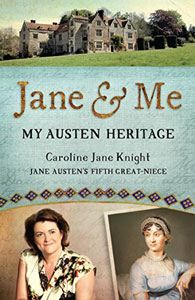 Jane & Me: My Austen Heritage: Caroline Jane Knight shares more than Jane Austen’s name and DNA. As a direct descendant of Jane’s brother, Edward Knight, Caroline is the last of the Austen Knight family to grow up at Chawton House on the estate where Jane Austen lived and enjoyed the most productive period of her writing career. Caroline explored the same places around Chawton House and its grounds as Jane did, dined at the same table in the same dining room, read in the same library and shared the same dream of independence.
Jane & Me: My Austen Heritage: Caroline Jane Knight shares more than Jane Austen’s name and DNA. As a direct descendant of Jane’s brother, Edward Knight, Caroline is the last of the Austen Knight family to grow up at Chawton House on the estate where Jane Austen lived and enjoyed the most productive period of her writing career. Caroline explored the same places around Chawton House and its grounds as Jane did, dined at the same table in the same dining room, read in the same library and shared the same dream of independence.
Caroline’s early life was filled with the delights of living in a sixteenth-century English manor, the good cheer of family gatherings and centuries-old Christmas traditions in the Great Hall of Chawton House, the beauty of a country life, and the joys of helping her Granny bake cakes and serve Jane Austen devotees in the Chawton House tea room. But when she was seventeen, Caroline and her family were forced to leave the home her family had lived in for centuries. Heartbroken, but determined to leave all things Austen behind her, Caroline eventually carved out a highly successful career in business.
This is the story of Caroline’s tumultuous journey to success, her ultimate crisis, her rediscovery and embrace of her Austen heritage, and the creation of the Jane Austen Literacy Foundation.

If you enjoyed this post, wander over to The Period Films List. You’ll especially like the Best Period Dramas: Georgian and Regency Eras List. Also see Costuming Pride and Prejudice, and Jane Austen Period Drama Gifts for You, and Mammoth is Adapting Pride and Prejudice. Don’t miss the PBS Masterpiece Fall 2017 Line-up! You can learn about the Chawton House Library as it is today, here.

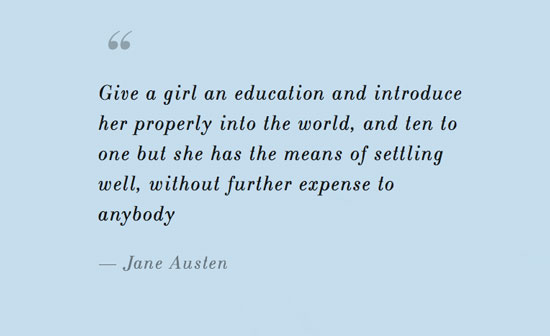

denise
August 27, 2017 at 11:12 pm (7 years ago)I have the book and cannot wait to read it. I enjoyed the Q&A.